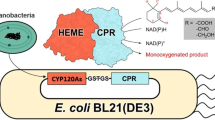Abstract
To engineer a “soluble” form of membrane-bound cytochrome P45017α (CYP17)—a key enzyme in steroid hormone biosynthesis—in the present work we have built a computer model of the tertiary structure of the hemeprotein, identified the surface hydrophobic amino acid residues, substituted these residues for more hydrophilic ones, and expressed and purified hydrophilized forms of CYP17. We have constructed and purified the following mutant forms of human CYP17: CYP17dH (CYP17 with deleted hydrophobic N-terminal sequence (δ23)) and CYP17mod (CYP17dH with substituted cluster of hydrophobic amino acid residues in the region of the FG-loop). Removal of the N-terminal sequence responsible for interaction with the membrane does not dramatically change the association of the protein with the membrane. However, CYP17mod containing hydrophilic FG-loop is mostly localized in the cytosolic fraction. Thus, in the present work we for the first time engineered a “soluble” form of the usually membrane-bound human CYP17 that is not bound to membrane. The expression degree of CYP17mod is approximately 900 nmol/liter of culture. The hemeprotein can be purified to apparent homogeneity without using detergents at any purification step. It is shown that replacement of hydrophobic amino acid residues in the FG-loop region does not change the metabolic profile during hydroxylation of steroids that is characteristic for wild type CYP17. Besides, the modification of the hemeprotein does not affect the affinity of CYP17 to steroid substrates. The engineered “soluble” form of human CYP17 is used as a subject for crystallization of the hemeprotein.
Similar content being viewed by others
Abbreviations
- DTT:
-
dithiothreitol
- IPTG:
-
isopropyl-β-D-thiogalactopyranoside
- OD:
-
optical density
- P4:
-
progesterone
- P5:
-
pregnenolone
- PMSF:
-
phenylmethylsulfonyl fluoride
References
Usanov, S. A., Chashchin, V. L., and Akhrem, A. A. (1990) in Molecular Mechanisms of Adrenal Steroidogenesis and Aspects of Regulation and Application, Vol. 3 (Ruckpaul, K., and Rein, H., eds.) Akademie-Verlag, Berlin, pp. 1–57.
Nebert, D. W., and Russel, D. W. (2002) Lancet, 360, 1155–1162.
Lieberman, S., and Warne, P. A. (2001) J. Steroid Biochem. Mol. Biol., 78, 299–312.
Shet, M. S., Fisher, C. W., Tremblay, Y., Belanger, A., Conley, A. J., Mason, J. I., and Estabrook, R. W. (2007) Drug Metab. Rev., 39, 289–307.
Gilep, A. A., Estabrook, R. W., and Usanov, S. A. (2004) Biochemistry (Moscow), 69, 364–375.
Qin, K. N., and Rosenfield, R. L. (1998) Mol. Cell. Endocrinol., 145, 111–121.
Miller, W. L. (2005) Med. Princ. Pract., 14,Suppl. 1, 58–68.
Auchus, R. J. (2001) Endocrinol. Metab. Clin. North. Am., 30, 101–119.
Ntais, C., Polycarpou, A., and Ioannidis, J. P. (2003) Cancer Epidemiol. Biomarkers Prev., 12, 120–126.
Sakaguchi, M., Mihara, K., and Sato, R. (1984) Proc. Natl. Acad. Sci. USA, 81, 3361–3364.
Neve, E. P., and Ingelman-Sundberg, M. (1999) FEBS Lett., 460, 309–314.
Gillam, E. M., Baba, T., Kim, B. R., Ohmori, S., and Guengerich, F. P. (1993) Arch. Biochem. Biophys., 305, 123–131.
Von Wachenfeldt, C., Richardson, T. H., Cosme, J., and Johnson, E. F. (1997) Arch. Biochem. Biophys., 339, 107–114.
Cosme, J., and Johnson, E. F. (2000) J. Biol. Chem., 275, 2545–2553.
Sagara, Y., Barnes, H. J., and Waterman, M. R. (1993) Arch. Biochem. Biophys., 304, 272–278.
De Lemos-Chiarandini, C., Frey, A. B., Sabatini, D. D., and Kreibich, G. (1987) J. Cell Biol., 104, 209–219.
Graham-Lorence, S., Amarneh, B., White, R. E., Peterson, J. A., and Simpson, E. R. (1995) Protein Sci., 4, 1065–1080.
Peterson, J. A., and Graham, S. E. (1998) Structure, 6, 1079–1085.
Gilep, A. A., Guryev, O. L., Usanov, S. A., and Estabrook, R. W. (2001) Biochem. Biophys. Res. Commun., 284, 937–941.
Omura, T., and Sato, R. (1964) J. Biol. Chem., 239, 2370–2378.
Porter, T. D., Wilson, T. E., and Kasper, C. B. (1987) Arch. Biochem. Biophys., 254, 353–367.
Poulos, T. L., Finzel, B. C., and Howard, A. J. (1987) J. Mol. Biol., 195, 687–700.
Boddupalli, S. S., Hasemann, C. A., Ravichandran, K. G., Lu, J. Y., Goldsmith, E. J., Deisenhofer, J., and Peterson, J. A. (1992) Proc. Natl. Acad. Sci. USA, 89, 5567–5571.
Lin, D., Zhang, L. H., Chiao, E., and Miller, W. L. (1994) Mol. Endocrinol., 8, 392–402.
Auchus, R. J., and Miller, W. L. (1999) Mol. Endocrinol., 13, 1169–1182.
Qiao, J., Hu, R. M., Peng, Y. D., Song, H. D., Peng, Y. W., Gao, G. F., Hao, J. H., Hu, N. Y., Xu, M. Y., and Chen, J. L. (2003) Mol. Cell Endocrinol., 201, 189–195.
Sansen, S., Yano, J. K., Reynald, R. L., Schoch, G. A., Griffin, K. J., Stout, C. D., and Johnson, E. F. (2007) J. Biol. Chem., 282, 14348–14355.
Hahm, J. R., Kim, D. R., Jeong, D. K., Chung, J. H., Lee, M. S., Min, Y. K., Kim, K. W., and Lee, M. K. (2003) Metabolism, 52, 488–492.
Gupta, M. K., Geller, D. H., and Auchus, R. J. (2001) J. Clin. Endocrinol. Metab., 86, 4416–4423.
Katagiri, M., Suhara, K., Shiroo, M., and Fujimura, Y. (1982) Biochem. Biophys. Res. Commun., 108, 379–384.
Akhtar, M. K., Kelly, S. L., and Kaderbhai, M. A. (2005) J. Endocrinol., 187, 267–274.
Author information
Authors and Affiliations
Corresponding author
Additional information
Published in Russian in Biokhimiya, 2008, Vol. 73, No. 7, pp. 999–1006.
Originally published in Biochemistry (Moscow) On-Line Papers in Press, as Manuscript BM08-048, June 1, 2008.
Rights and permissions
About this article
Cite this article
Pechurskaya, T.A., Lukashevich, O.P., Gilep, A.A. et al. Engineering, expression, and purification of “soluble” human cytochrome P45017α and its functional characterization. Biochemistry Moscow 73, 806–811 (2008). https://doi.org/10.1134/S0006297908070092
Received:
Published:
Issue Date:
DOI: https://doi.org/10.1134/S0006297908070092




